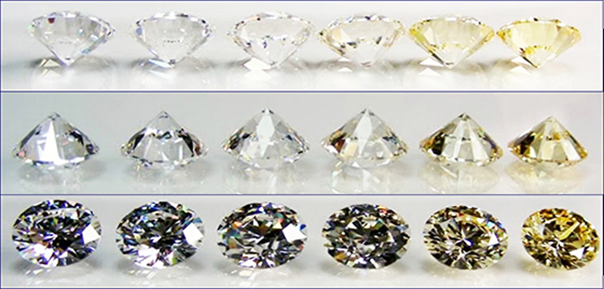Why a diamond certificate ?
The advantage of a diamond with certificate GIA or EGL USA
Be sure that the diamond has been certified by one of the three internationally recognized gemological laboratories : GIA or EGL USA :
it is a guarantee, protecting you against arbitrariness, guarding you from ignorance and thus deception. And it drives the price.
The GIA and EGL USA Diamond Certificate are the most comprehensive and secure diamond certificate you will find. It provides you with a detailed description of your diamond's 4 Cs and can be ordered with laser inscription.
Diamonds of over 0.30 ct are usually certified. For these stones, Daniellamore.com only supplies certified diamonds; the paperwork can be seen online and is supplied upon purchase.
Full Diamond Grading Reports
These reports include an assessment of the 4Cs of the diamond, measurements and other important parameters of the diamond, together with a high resolution picture of the diamond and a graphic image of its proportions. A diagram of its specific clarity is optional.
The 4Cs
The quality of a diamond is determined by what is known as the 4Cs: carat, color, clarity and cut. These four characteristics are what will decide the value of the stone.
Carat
A diamond's weight is given in carats. The term carat derives from the fact that the seeds of the Carob tree were used on precision scales as units of weight for small quantities of precious stones.
1 carat equals 0.2 grams, meaning a 5 carat diamond weighs 1 gram.
The carat weight influences the cost of the diamond since the cost rises significantly per carat. But a 1.00 carat diamond won't necessarily cost exactly half the price of a 2.00 carat stone since other factors are also important.
When buying a diamond, look for one that is as close as possible to the next carat weight. The cost of a 1.94-carat stone will be much less than one weighing 2.00 carats even though there is only a difference of six points between them.
Color
The single most important factor in grading and valuing colored diamonds is their color. The color, hue and tone of the diamond is compared to the lightness or darkness of the color to determine the grading, or quality of the stone. The body color of a stone influences the appearance of a diamond and its price. Color is part of the natural composition of the diamond and never changes over time. It is caused by varying quantities of nitrogen and other trace elements, present in all diamonds, which dislodged the carbon atoms within the crystal's structure.
How is a diamond's color determined? The almost universally agreed way of grading is by using the CGL's color scale.

Cut
There are many shapes of diamonds with different proportions, polish and finish. Each shape has its own characteristics which influence the brilliance and beauty of the diamond.
Among the most common diamond shapes on the market are the Round Brilliant, and stones with a special polish called fancy shapes, such as Marquise, Oval, Pear, Heart and Princess.
Clarity
The clarity of a diamond relates to whether it has inclusions, or flaws, inside it. Most diamonds have flaws – they were formed when they were created millions of years ago deep underground. If the diamond has inclusions, it will command a lower price because its clarity is reduced. Scratches, or blemishes on the exterior of a diamond also have an effect on the clarity.
The diamond industry generally uses five levels of clarity.
FL – Flawless
No blemishes on the surface or inclusions in the stone when examined by a skilled grader using 10X magnification. The most expensive diamond because it is flawless.
IF – Internally Flawless
IF stands for Internally Flawless. Such a diamond does not have any internal flaws, although it may have some surface blemishes. Such diamonds are extremely rare and, consequently, are the most expensive.
VVS1-VVS2 – Very Very Slightly Included
VVS is Very Very Slightly Included of which there are two grades. The diamond has tiny inclusions which are very difficult to detect without a 10x magnification by a trained gemologist.
VS1-VS2 – Very Slightly Included
VS1-VS2 are two grades of Very Slightly Included. These inclusions are so small that they can only be seen with difficulty using 10x magnification.
SI1-3 – Inclusions
I1-3 are inclusions which are big enough to be seen using 10x magnification and in some cases the inclusions can be spotted with the naked eye depending on the size of the inclusion.
 30 DAYS TRIAL AT HOME
30 DAYS TRIAL AT HOME SECURE AND INSURED SHIPPING
SECURE AND INSURED SHIPPING SECURE ONLINE PAYMENTS
SECURE ONLINE PAYMENTS CERTIFIED DIAMONDS
CERTIFIED DIAMONDS UP TO - 50% CHEAPER THAN ORDINARY JEWELRY
UP TO - 50% CHEAPER THAN ORDINARY JEWELRY